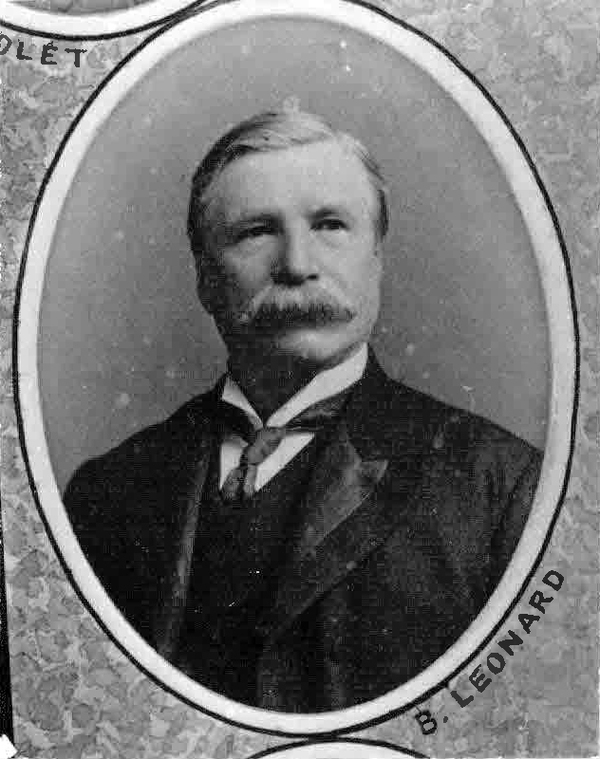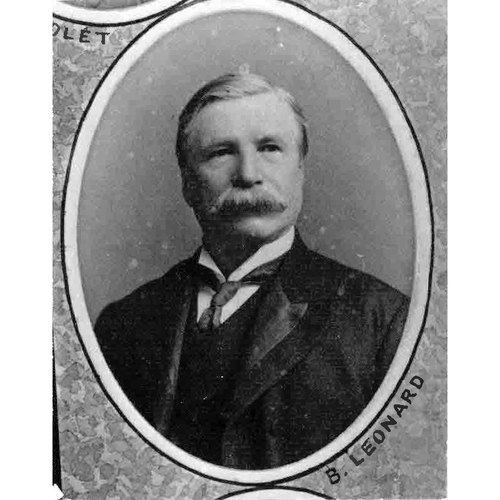
Source: Link
LEONARD, BERNARD, painter, glazier, merchant, interior decorator, manufacturer, and politician; b. 1841 in Enniskillen (Northern Ireland), son of Bernard Leonard and Mary McKenna; m. 7 Feb. 1871 Catherine (Kate) Kirwin (Kerwin) at Quebec, and they had eight children; d. there 20 March 1924.
Bernard Leonard immigrated to Quebec with his family in 1846. His schooling was of short duration. In his youth he was trained as a painter by his compatriot Charles McDonald, a painter and dealer in hardware, wallpaper, and carpets, and he worked for him from 1863 until 1869, when he went into business on his own at 8 Rue de la Fabrique. Leonard first gained fame for his decorative painting (in particular the decor he installed in the Music Hall in November 1871 on the occasion of a ball to mark the departure of the 60th Foot, as well as the murals he painted for the Quebec legislative building in 1883) and even for his signs, which won a prize at the Quebec provincial exhibition in 1877. Over the years he became interested in other areas. By 1876, for example, he was advertising himself as a glazier and importer of wallpaper and earthenware.
Three years later, a sensible businessman, he set up shop permanently on Rue Saint-Jean, the major commercial thoroughfare of Quebec’s Upper Town. A sign bearing his name, mounted under the cornice, still identifies what is now no.1117 as his premises. The purchase of this building in 1889 marked an important turning point for his business: in that year his eldest son, John Kirwin, fresh out of the Académie Commerciale de Québec, took his place in the family company, B. Leonard, which now had some 40 employees. John Kirwin became a partner in his father’s firm in 1895, and the following year also joined forces with his brother Bernard James to form Leonard Brothers, which owned the Quebec Shoe Store, a high-quality footwear shop a few doors away from the B. Leonard store. In 1900 William Henry, the artist in the family, came into the business as assistant to Wallace J. Fischer, an English stained-glass artist. Fischer had been hired to set up a stained-glass window factory in 1896–97 and to take charge of the painted decorations. Some ten years later B. Leonard had 150 workers. When Fischer left around 1921, William Henry assumed responsibility for the workshop and the store on Rue Saint-Jean. After their father’s death, the Leonard brothers would concentrate more on interior decorating and stained-glass windows and discontinue the sale of wallpaper, pigment, varnish, and paint. On William Henry’s death in 1940, the factory would cease to exist and the company would be purchased by Ernest Legault, who would give it up around 1948.
The establishment of the factory at 31 Rue Saint-Stanislas, close to the store that already had been recognized as the largest wallpaper retailer in eastern Canada, is an indication of the Leonard family’s entrepreneurial spirit. According to the 1891 census, there were only three “stained-glass window factories” in the province of Quebec, all of them in Montreal. Bernard Leonard and his eldest son wanted, it would seem, to take advantage of the current mania for stained-glass windows to add a promising sector to their business and to get ahead of the competition by employing a true stained-glass artist who could design and create large works that were consistent in both construction and iconography. Fischer had learned his trade in England, France, and Germany, as can be seen from his work, especially the religious windows he produced between 1897 and 1921. The 41 stained-glass windows of the church of Saint-Jean-Baptiste at Quebec, installed between 1897 and 1912, constitute the largest contract Fischer carried out for the B. Leonard company. As well, at Quebec he made the windows for the chapels of the seminary, the Ursulines, the Augustines, and the Congrégation des Hommes de la Haute Ville, and some of the commemorative windows in St Matthew’s, Chalmers Free, and Wesley Methodist churches, the Baptist church, and others. To these approximately 100 windows that remain in their original setting must be added those that were destroyed or moved, including the ones in the former chapel of Notre-Dame-du-Chemin, which since 1986 have been safely lodged in the church in Amqui. Stained-glass windows by Fischer are still in place at Cacouna, Chicoutimi, Deschambault, and Saint-Isidore (near Quebec), on the Île d’Orléans, and in other parts of the province. In addition to religious windows, B. Leonard designed and produced many stained-glass windows for public buildings, businesses, and residences of wealthy merchants at Quebec and even in Montreal. Most of these are no longer extant, or cannot be positively identified since the company’s works were seldom signed. Like the interior decorations, they have fallen victim to fashion and periodic renovations, or, in some cases, to demolition.
Having guaranteed the future of his sons by bringing them into the business, Bernard Leonard devoted himself increasingly to other activities. He became involved in mining exploration and in 1907 was vice-president of the Chibougamoo Mining Company Limited and the Great Northern Gold Fields Company. He was also active in municipal affairs. Between 1890 and 1906 he was elected alderman of Saint-Louis ward six times, and he served on the municipal health, water, fire, and other committees. He certainly turned this experience to good advantage as president of the Industrial Life Insurance Company, which was founded in 1904 at his home on Rue Grande Allée with the participation of legislative councillor Némèse Garneau*, merchant Gaspard Le Moine, and his son John Kirwin. Incorporated in May 1905, it was authorized to write policies for accident, health, and life insurance. From 1905 to 1922 Bernard Leonard was elected president every year and the firm grew steadily. In 1906 two offices were opened in Montreal and another in Drummondville. The net value of the policies in force rose from $4,764.55 at the end of 1906 to $453,348.11 on 31 Dec. 1921. In February 1922 John Kirwin succeeded his father as president, an office he would retain until 1944, when Esmond, Bernard’s youngest son, would take over. Esmond would finally dispose of his shares in 1950, thereby putting an end to the Leonard family’s association with the business. A portrait of Bernard Leonard, painted in 1930 by Lucien-Raoul-Jean Martial and still kept at Quebec in the building of what is now the Industrial Alliance Life Insurance Company, is a reminder of this connection.
According to the Album biographique des membres du conseil de ville de Québec, published by Léon Lortie, Bernard Leonard was the president, around 1895, of two Irish organizations in the city, the Irish Catholic Benevolent Society and St Patrick’s Literary Institute of Quebec. But it was mainly by his good taste, together with his undeniable business sense, that he made a reputation for himself. He trained many artists and decorators. To have worked for his company was a guarantee of success, as La Semaine commerciale pointed out in March 1900, when the Simard brothers opened a store in Quebec’s Lower Town: “These gentlemen have spent ten years in the employ of the . . . Leonard company as painters [and] decorators, tapestry workers, etc. Given such a record of service, it seems to us unnecessary to recommend them.”
ANQ-Q, CE301-S98, 7 févr. 1871. AVQ, QP1-4, 41/0002. Industrial Alliance Life Insurance Company (Quebec), Minutes of the directors’ meetings, 1905–30; Minutes of the shareholders’ meetings and financial statements, 1905–30. L’Action catholique (Québec), 21 mars 1924, 17 juin 1940. Daily Telegraph (Quebec), 1 Jan. 1900. L’Événement, 21 mars 1924. Montreal Herald, 8 Nov. 1890. La Semaine commerciale (Québec), 22 déc. 1899, 9 mars 1900. Canada ecclésiastique, 1914–20. The Canadian trade review: an illustrated descriptive edition of the city of Quebec and district, treating of their history, resources, industries, scenery and waterfalls ([Montreal?, 1908?]), 65, 87. Directories, Quebec, 1863–89; Quebec and Lévis, 1890–1950. Jacques Lapointe, “Monographie de l’Industrielle, cie d’assurance-vie” (mémoire de m.sc.c., univ. Laval, Québec, 1950). Ginette Laroche, “Des vitraux ‘made in Quebec,’” Cap-aux-Diamants (Québec), 2 (1986–87), no.3: 7–9; Stained-glass windows (Quebec, 1999). Léon Lortie, Album biographique des membres du conseil de ville de Québec, 1894–95 (Québec, 1895). “La Semaine commerciale”; dépouillement de la ‘colonne de l’entrepreneur’ 1894 à 1913: le Vieux-Québec, le faubourg Saint-Jean, la Grande-Allée, Robert Caron, compil. (Québec, 1983). Une page d’histoire de Québec; magnifique essor industriel ([Montréal, 1955]), 476–82.
Cite This Article
Ginette Laroche, “LEONARD, BERNARD,” in Dictionary of Canadian Biography, vol. 15, University of Toronto/Université Laval, 2003–, accessed December 4, 2025, https://www.biographi.ca/en/bio/leonard_bernard_15E.html.
The citation above shows the format for footnotes and endnotes according to the Chicago manual of style (16th edition). Information to be used in other citation formats:
| Permalink: | https://www.biographi.ca/en/bio/leonard_bernard_15E.html |
| Author of Article: | Ginette Laroche |
| Title of Article: | LEONARD, BERNARD |
| Publication Name: | Dictionary of Canadian Biography, vol. 15 |
| Publisher: | University of Toronto/Université Laval |
| Year of publication: | 2005 |
| Year of revision: | 2005 |
| Access Date: | December 4, 2025 |



